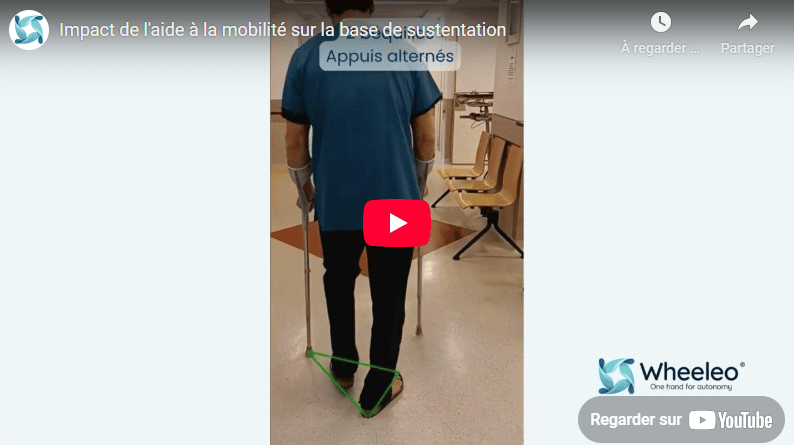
The base of support corresponds to the delimited surface by the projection of the various points of support of a person and their technical walking aid (TWA).
The mobility aid therefore directly influences the base of support. Depending on the type of TWA, its mode of use, and the objectives pursued, the base of support varies throughout the gait cycle. Walkers and walking frames (one-handed, two-handed) are the only mobility aids that modify the base of support throughout the entire gait cycle. This is why they are particularly useful in cases of significant balance disorders.
Alternation between a large rectangular surface (double support) and a small surface (single-leg support). To adopt a 2-point gait, sufficient stability is required. The weakest individuals will spontaneously adopt a 3-point gait (see below).
Alternation between a large triangular surface (double support) and a small surface (single-leg support).
Alternation between a triple support (laterally spread surface) and a single-leg support. This gait offers good lateral stability but is less stable anteroposteriorly. The primary objective is weight-bearing relief.
Alternation between support on both crutches (complete replacement of foot support) and single-leg support. This gait, focused on weight-bearing relief, is very stable laterally but remains limited in anteroposterior stability, allowing the body to move forward.
Alternation between double supports (one crutch and the opposite foot). This gait ensures symmetrical weight-bearing relief and stability for people with bilateral deficits. Each foot support is doubled by a crutch support. The Wheeleo® one-handed walker also allows doubling of each support while freeing one hand.
Alternation between double supports (one pole and the opposite foot). This gait improves balance throughout the entire gait cycle. The handles are placed in a high position (bent elbows) because the goal is not to push hard but to benefit from the change in the base of support by taking one or two additional ground supports.
Three distinct phases:
This approach allows for maintaining a large base of support throughout the cycle, without a single-leg support phase. It is used to compensate for situations of great instability. Unfortunately, this compensation to eliminate the effect of lifting the cane has an impact on the gait.
The Wheeleo® one-handed walker provides stability (always two points of support, thus a large base of support) without altering the natural walking pattern.
Alternation between a double support of Wheeleo®/opposite foot and a double support of Wheeleo®/adjacent foot. The use of Wheeleo® improves stability without disrupting the natural walking pattern, offering an effective solution in many situations.
This article demonstrates how the base of support is a fundamental concept in the selection and use of walking aids. Understanding these principles allows for optimizing safety, stability, and gait quality for each patient.
Please fill in this short form so that we can contact you to arrange a test.